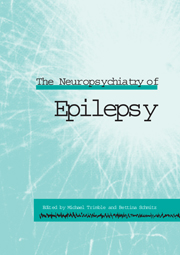Book contents
- Frontmatter
- Contents
- List of contributors
- Part I Background
- 1 Introduction
- 2 Neuropsychiatric disorders in epilepsy – epidemiology and classification
- 3 Limbic connectivity: anatomical substrates of behavioural disturbances in epilepsy
- Part II Clinical aspects
- Part III Cognitive aspects
- Part IV Nonepileptic attacks
- Part V Treatment complications
- Part VI Treatment
- Index
1 - Introduction
Published online by Cambridge University Press: 05 October 2010
- Frontmatter
- Contents
- List of contributors
- Part I Background
- 1 Introduction
- 2 Neuropsychiatric disorders in epilepsy – epidemiology and classification
- 3 Limbic connectivity: anatomical substrates of behavioural disturbances in epilepsy
- Part II Clinical aspects
- Part III Cognitive aspects
- Part IV Nonepileptic attacks
- Part V Treatment complications
- Part VI Treatment
- Index
Summary
In 1997, Dr Pete Engel, President of the International League Against Epilepsy, invited us to establish a commission on psychobiology, and this book represents one of the achievements of the commission's work. The task of the commission was to explore the interface between epilepsy and behaviour disorders, from a biological and social point of view. To these ends a number of subcommissions were established, and their task was to explore the existing knowledge base of the discipline, to suggest research strategies for interventions and to educate both patients and carers about aspects of epilepsy which a number of people consider to have been neglected.
The present book is divided into several parts, covering a spectrum of clinical topics which have been of concern to the commission. Some old chestnuts, for example the interictal psychoses of epilepsy, have not been allocated specific chapters, and a number of other areas, particularly relating to learning disability, cognitive decline, dissociative attacks and vagus nerve stimulation have been included. It is hoped that by expanding upon the literature on some of these less-well-discussed aspects of psychobiology in epilepsy further interest will be stimulated, leading to both intellectual discussion and research endeavours.
We start our text with an introduction to the classification of psychiatric disorders in epilepsy. The point is made that existing classifications used in psychiatry such as the DSM– IV are quite inadequate when it comes to dealing with the subtleties of the behaviour changes of patients with neurological disorders.
- Type
- Chapter
- Information
- The Neuropsychiatry of Epilepsy , pp. 3 - 4Publisher: Cambridge University PressPrint publication year: 2002
- 7
- Cited by



